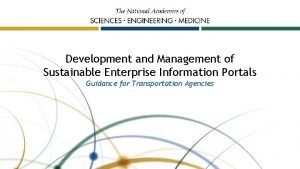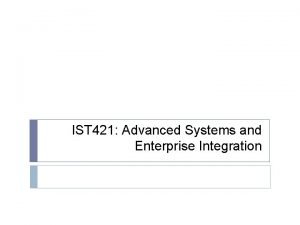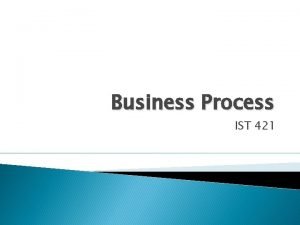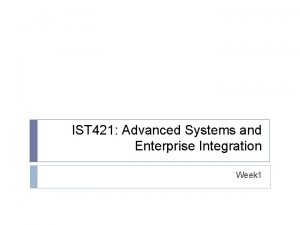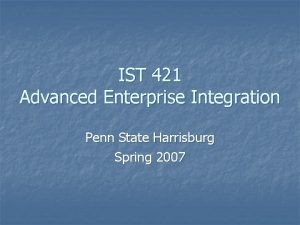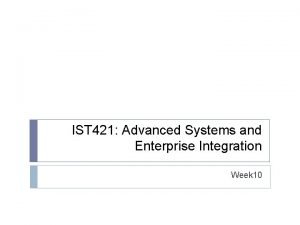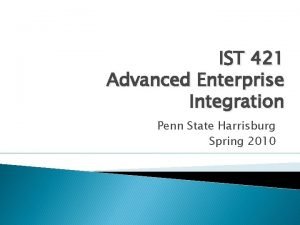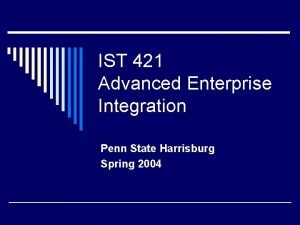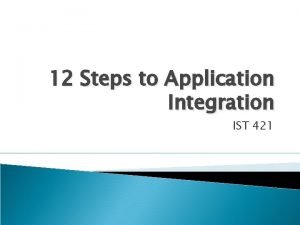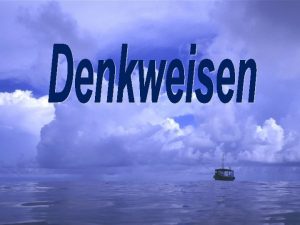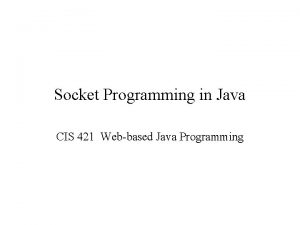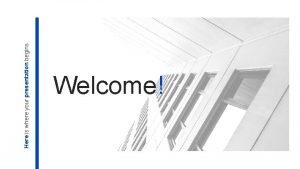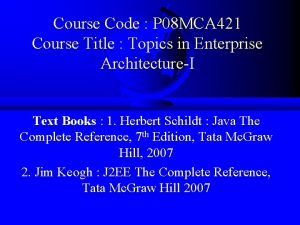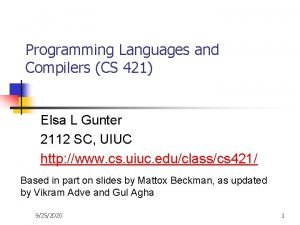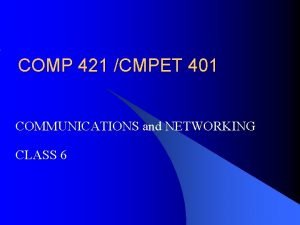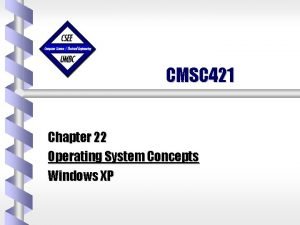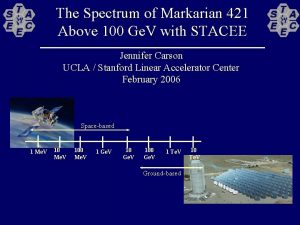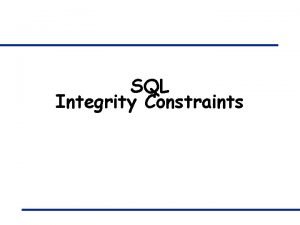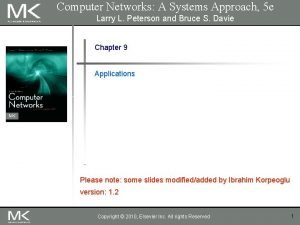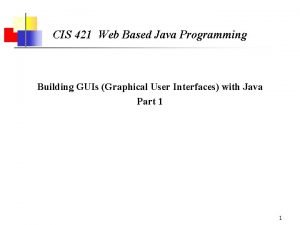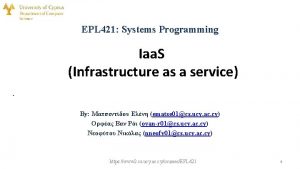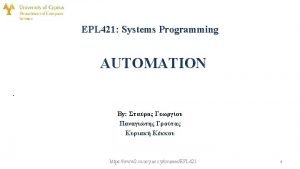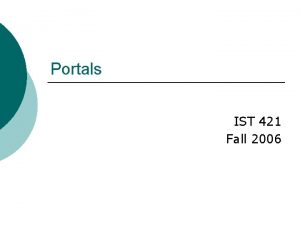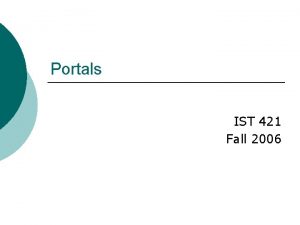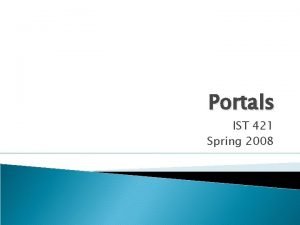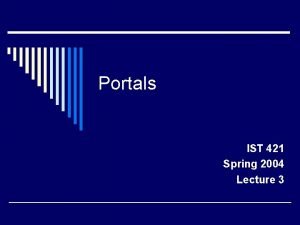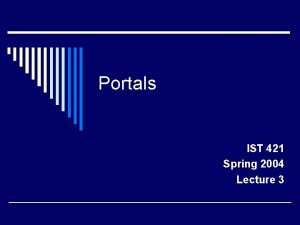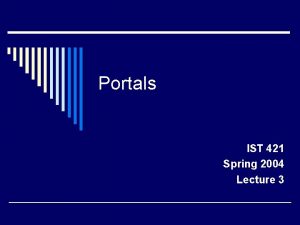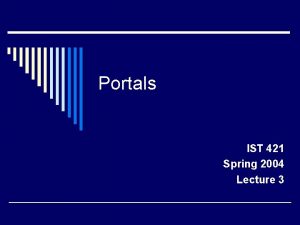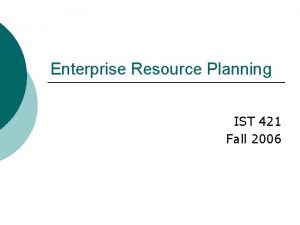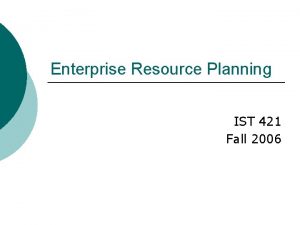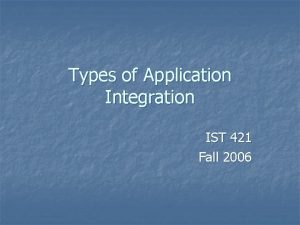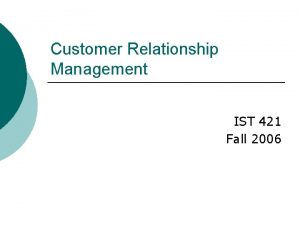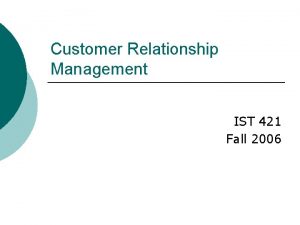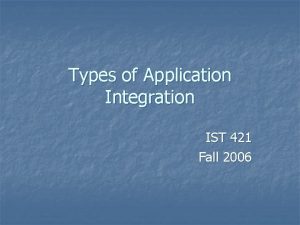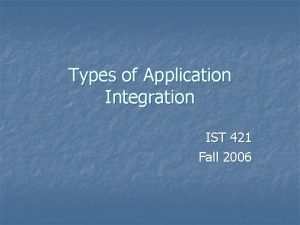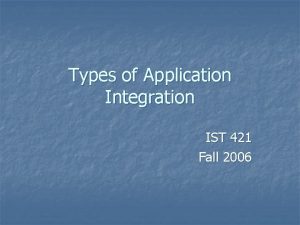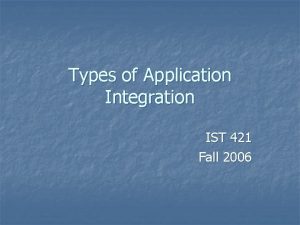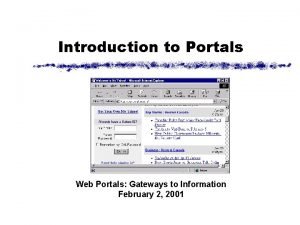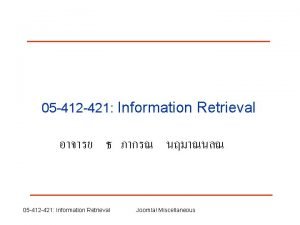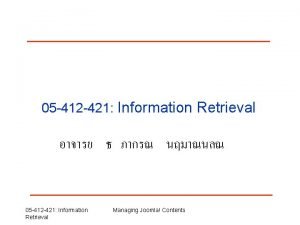Portals IST 421 Fall 2006 Enterprise Information Portals








































- Slides: 40

Portals IST 421 Fall 2006

Enterprise Information Portals – doorway to a focused set of resources either internal or external ¡ Targeted for a specific audience ¡ l ¡ Employees, customers, suppliers Serve as a single coherent view of information aggregated from different sources

Enterprise Information Portals ¡ Back Office Systems - ERP, financials, human resources, engineering, process automation/workflow, project management ¡ Front Office Systems – sales force automation, customer relationship management, help desk, marketing automation ¡ Personal Productivity Systems – word processor, spreadsheet, presentation, contact manager, personal information manager

Enterprise Information Challenges ¡ Managed data l l ¡ Legacy systems, proprietary systems Disconnected islands of automation Unmanaged data l l l Ad-hoc productivity tools Chaotic access and exchange Restricted publication rights

Enterprise Information Portals A system to manage access to information ¡ Adopt a standard for transmitting and representing data using XML ¡ Content must be abstract and kept separate from rendition ¡ l Rendition – the file format that contains the actual data and the description of the format

Enterprise Information Portals Primary advantage is that there is no need to integrate systems directly between companies or within trading communities ¡ Connect to each system through a point of integration ¡ l User interface, database, application server

Enterprise Information Portals ¡ Today, more information flows through user interfaces than automatically through back-end integration

Portal Advantages Supports a noninvasive approach ¡ Faster to implement than real-time information exchange ¡ Technology is mature with many portal-oriented applications to learn from ¡

Portal Disadvantages Information does not flow in real time ¡ Requires human interaction ¡ Information must be abstracted through another application logic layer – complexity issue ¡ Security is a concern when data is being extended to users over the Web ¡

Portal Evolution ¡ Single-System Portals l ¡ Single enterprise systems that have their user interfaces extended to the Web Multiple Enterprise System Portals l Multiple enterprise systems information is funneled through a single Webenabled application

Portal Evolution ¡ Trading Community Portals l Multiple enterprise system portal is extended to include systems within many companies – trading community portal or digital exchange

Portal Architecture ¡ Made up of components: l l l Web clients Web servers Database servers Back-end applications Application servers

Portal Server Architecture From The XML Handbook by Goldfarb and Prescod, Prentice Hall PTR, 2001.

Portal Architecture ¡ Web Clients – any device able to run a Web browser and display HTML and graphics l ¡ PC, PDA’s, cell phones Web Servers – file servers able to convert information into HTML and deliver to a Web browser using HTTP

Portal Architecture Database Servers – work as a traditional client/server architecture ¡ Back-End Applications – mix of applications such as SAP, custom applications, client/server applications ¡ l Portals gather appropriate information from these systems and present it to the user interface

Portal Architecture ¡ Application Servers – provide a middle layer between the back-end applications, databases, and the Web server.

Portal Servers ¡ Three requirements for portal servers: l l l Performance: reliability, availability, scalability Content distribution to PC’s, thin clients, mobile devices such as phones and PDA’s; personalization Business process integration

Portal Server Architecture ¡ Personalization l l l Content delivery agents (CDA) is a program or script that creates a window for providing a data source Each user is assigned a “role” which specifies a collection of pages, CDS’s, and a default theme User may change the layout of any page, change the color and background images of the desktop

EDI

EDI ¡ Short for Electronic Data Interchange l l the transfer of data between different companies using networks, such as the Internet. ANSI has approved a set of EDI standards known as the X 12 standards. Source: www. webopedia. com/TERM/E/EDI. html - 46 k - Sep 14, 2005

EDI Business Transaction Cycle Here is a typical EDI business transaction cycle using a dial-up or network connection to a Value-Added Network (VAN): 1. Customer sends a purchase order (EDI 850) 2. Supplier sends an acknowledgement notice (EDI 997) 3. Supplier sends an advance shipping notice (EDI 856) 4. Customer sends an acknowledgement notice (EDI 997) 5. Supplier sends an electronic invoice (EDI 810) 6. Customer sends another acknowledgement notice (EDI 997) 7. Customer sends an Electronic Funds Transfer (EFT) payment Source: http: //www. edi-101. com/edi-cycle. htm

Sample ¡ http: //www. ediservice. com/stds_rqst. htm

Service-Oriented Application Integration

Service-Oriented Application Integration ¡ Enterprises share common application services and information l l l Define application services they can share Provide infrastructure for application service sharing Examples: Sharing common logic to process customers’ credit ¡ Calculate shipping costs ¡

Service-Oriented Application Integration ¡ Requires changes to most enterprise and B 2 B applications to take advantage l l Expensive proposition Concern about creating applications that share services not under direct control

Service-Oriented Application Integration ¡ Web Services l Ability to access remote application services through a well-defined interface, directory, and transport protocol Web Services Description Language (WSDL) ¡ Universal Description, Discovery and Integration (UDDI) ¡ Simple Object Access Protocol (SOAP) ¡

Web Services Description Language (WSDL) ¡ Provides a standard on interfaces between client and server l l Defines an XML grammar to describe network services Recipe to automate the way applications communicate

Universal Description, Discovery and Integration (UDDI) ¡ Set of databases where businesses register their Web services l l l Allows other organizations to find Web service Understand how to access service programmatically Understand the interfaces employed

Web Services Locate the service using UDDI ¡ Determine the interface definition using WSDL ¡ Application services exposed by a company that are discoverable and accessible by other organizations ¡ l l l Example: reserving a flight, calculating tariffs Discrete business services Value to many organizations

Web Services Web services tend to be created in a series of small, low risk steps ¡ Combine information and applications that exist in local and remote information systems ¡ l l Redundant application services at two or more systems New application need

Web Services ¡ Event-driven Web Services – architecture that deals more with information movement than application service aggregation

Web Services ¡ Composite-application Solutions – architecture that requires many application services to aggregate into a single instance of an application

Web Services ¡ Autonomous-distributed Solutions – architectures where Web services are tightly coupled, appear as a single application l Very future architecture

Web Services ¡ Missing Pieces l l l No mechanism to leverage user interfaces Lack support for authentication, encryption and access control Lack ability to authenticate publishers or consumers of services

Application Integration ¡ Rule l l Agreed-upon set of conditions Example: employees may not fly first class on flights of less than 5, 000 miles Rules are built into applications to control information flow Rules can control the flow of information between enterprises

Application Integration ¡ Logic l l l Sequence of instructions in a program Example: when button is pressed, pop up this screen Logic tends to be generated differently by different programmers, i. e. , form of art Sequential processing ¡ Selection ¡ Iteration ¡

Application Integration ¡ Data l ¡ Information that is shared between applications, computers, or humans Objects l Data and business services bound as objects

Amazon. com Books? ¡ CD’s ¡ Technology Company? ¡

Amazon. com ¡ Amazon Web Services l l Patented one-click purchasing system Tap quickly into sales data for particular products Merchants & developers can get free access to services Can use services from any outpost on the Web

Amazon. com May sell wares to 37 million customers assembled at Amazon. com ¡ Amazon takes a commission of 15% ¡ Is Amazon an on-line mall? ¡ Some of the retailers that use its ecommerce system ¡ l l Lands’ End Circuit City Store Target Corp Toys ‘R’ Us
 Mykrispykreme.com
Mykrispykreme.com Enterprise information portals
Enterprise information portals Ist 421
Ist 421 Processist
Processist Ist 421
Ist 421 Ist 421
Ist 421 Advanced systems integration
Advanced systems integration Ist 421
Ist 421 Ist 421
Ist 421 Ist 421
Ist 421 Winter kommt winter kommt flocken fallen nieder
Winter kommt winter kommt flocken fallen nieder Es ist kalt es ist kalt flocken fallen nieder
Es ist kalt es ist kalt flocken fallen nieder Ich habe heute klassendienst
Ich habe heute klassendienst Es ist herbst bunte blätter fliegen
Es ist herbst bunte blätter fliegen Zu glauben ist schwer. nichts zu glauben ist unmöglich
Zu glauben ist schwer. nichts zu glauben ist unmöglich Putting the enterprise into the enterprise system
Putting the enterprise into the enterprise system Putting the enterprise into the enterprise system
Putting the enterprise into the enterprise system 421 could not create socket
421 could not create socket Elsa gunter uiuc
Elsa gunter uiuc 421 rule
421 rule +91 620 421 838
+91 620 421 838 4 2 1 rule
4 2 1 rule 421 rule
421 rule 4-2-1 maintenance fluids
4-2-1 maintenance fluids Uw cse 421
Uw cse 421 Fwm 421
Fwm 421 Fwm 421
Fwm 421 Uiuc cs 421
Uiuc cs 421 Comp 421
Comp 421 Cmsc 421
Cmsc 421 Markarian 421 transmission
Markarian 421 transmission Biba n 421 ddl
Biba n 421 ddl Cs 421 bilkent
Cs 421 bilkent Shell and tube heat exchanger in food industry
Shell and tube heat exchanger in food industry Steam generator heat exchanger
Steam generator heat exchanger Cis 421
Cis 421 Psy
Psy Cs 421 uiuc
Cs 421 uiuc Cs 421 uiuc
Cs 421 uiuc Epl421
Epl421 Epl 421
Epl 421

